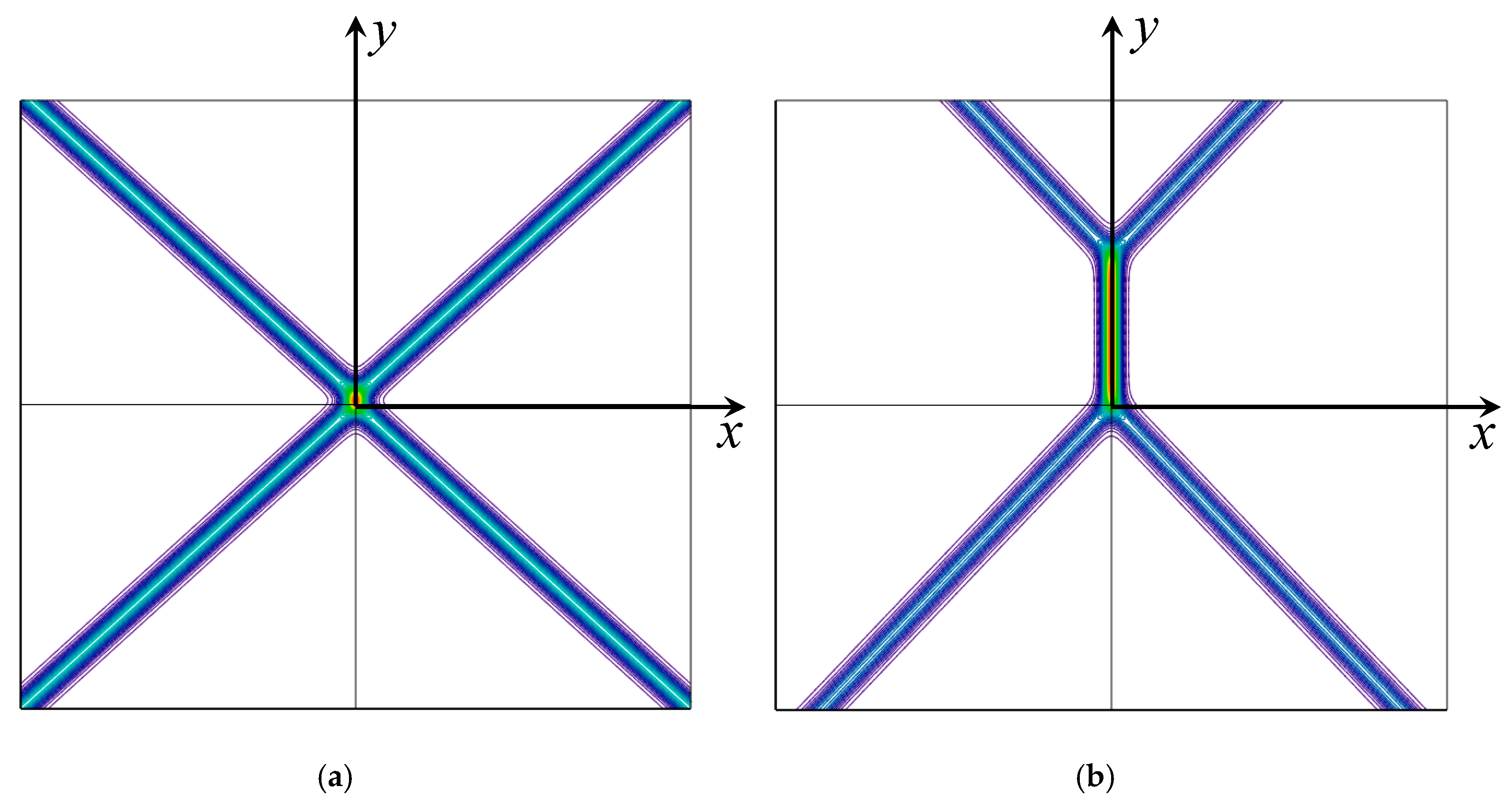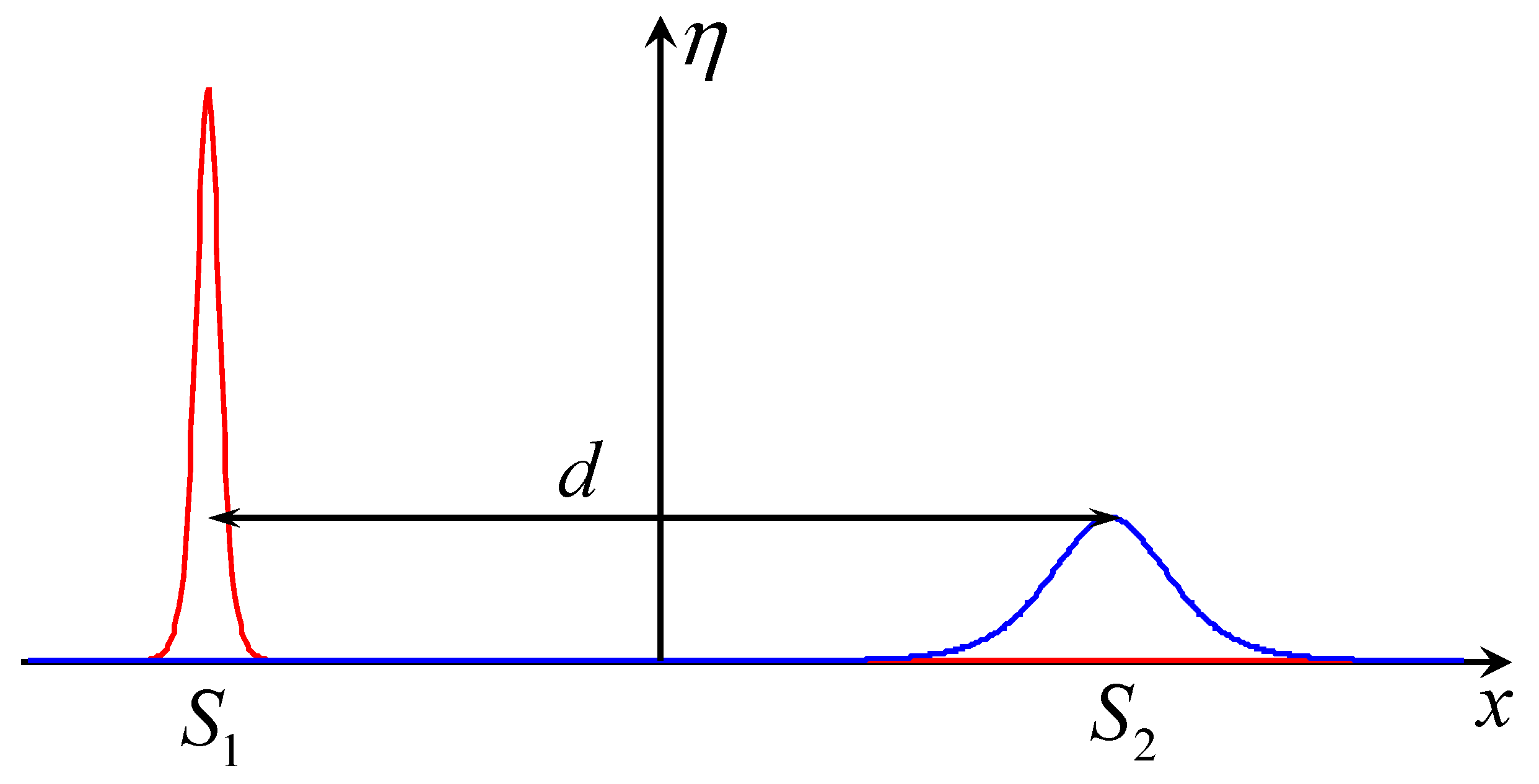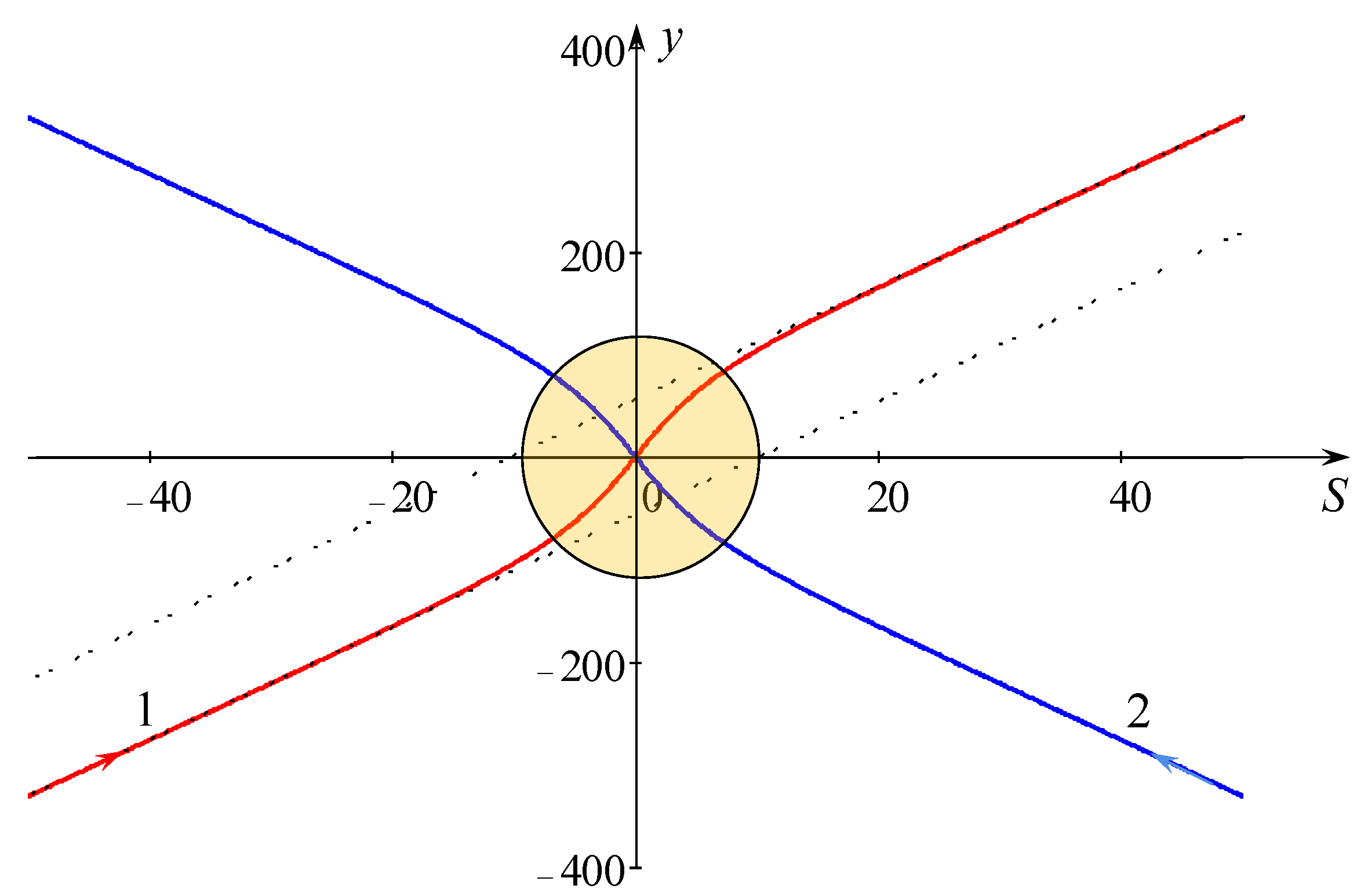3.1. Symmetric Configuration of Two Plane Solitons in the KP2 Equation
Let us consider the simplest pattern consisting of two interacting solitons shown in
Figure 2. In this case, the pattern is stationary in the coordinate frame moving with the speed
Vpat as per Equation (17). Then, the KP2 Equation (1) can be presented in the form:
This equation resembles the Boussinesq equation alias “the equation of a nonlinear string” [
1], where
y plays a role of time
t, and
C02 = 2
Vpat/
c plays a role of the squared speed of long linear waves. Thus, Equation (20) can be considered as the one-dimensional equation in space and “time
y” with the following soliton solution:
where ∆
2 = 12
β/
αA, and
W2 = (2/
c)(
Vpat −
αA/3); the solution exists if
Vpat >
α A/3. Soliton fronts shown, for example, in
Figure 2 can be treated as the space-time diagrams for the soliton solutions of the Boussinesq Equation (20).
According to the asymptotic theory developed in [
5,
6,
7], a solitary wave having big distances from other solitary waves can be considered as a classical particle in the external fields produced by the asymptotes of all other solitary waves. Considering only two solitons, we can seek a solution to Equation (20) in the form
η = η1 + η2 where
η1,2 represent two separate soliton solutions described by Equation (21). Then the soliton of amplitude
A1 being at a big distance from another soliton of amplitude
A2 (see
Figure 3) experiences its influence only through the exponentially small asymptotic (a “tail”) of the second soliton field. The tail part of the soliton field follows from the asymptotic solution of Equation (21),
η = 4
A2 exp(–2
d/∆), where
d is the distance between the soliton maxima along the
x-axis. The external field produced by the second soliton and represented by its “tail” can be considered as slowly varying in the space pedestal; at the place of the first soliton, the tail field is almost constant because it is assumed that the characteristic scale of pedestal variation in space is much greater than the characteristic width of the first soliton; this is shown schematically in
Figure 3. A soliton solution of Equation (20) on the constant pedestal
p is the same as in Equation (21), but with the modified speed,
; the solution exists if
Vpat >
α A/3 +
α p.
If we denote by
S1,2 the positions of soliton centres, then the kinematic condition of soliton motion requires that
Ṡ1,2 = ±
W1,2, where
Ṡ stands for the derivative of
S with respect to the “effective time”
y, and the signs ± pertain to solitons moving to the right or left. Considering solitons moving towards each other, we can set
Ṡ1 = −
W1, and
Ṡ2 =
W2. In the expressions for
W1,2, we can substitute instead of the constant pedestals
d1,2 the expressions of the tails of reciprocally external solitons or simply the external soliton fields, because we assume that the distance between the solitons is much greater than their characteristic width, |
S1 −
S2| >> ∆
1,2. Thus, we obtain the set of two equations for
S1,2:
where the upper sign pertains to the soliton at
S2, and the lower sign—to the soliton at
S1. Here the slowly varying pedestal
p1.2(
y) is determined by Equation (21).
This set of equations looks incomplete and seemingly needs to be augmented by the dynamical equations for the soliton amplitudes
A1,2(
y). However, soliton amplitudes experience variations only within a relatively short time when the “effective particles” experience a head-on collision. Therefore, in the first approximation, we can assume that soliton amplitudes remain unchanged and equal to their values at the infinity, i.e., far from the collision zone where the soliton fronts intersect (see
Figure 2a). Substituting in Equation (22)
A1,2 = 3
β k2/
α and
Vpat from Equation (17), we obtain:
Note, that for the symmetric solution considered here (see
Figure 2)
A1 =
A2 =
A, and a real solution to Equation (23) exists provided that
(cf. Equations (14) and (15)). Equation (23) can be readily solved. To this end, we note that
S1 +
S2 = 0 in the symmetric case; subtracting then one equation from another and denoting
X =
S2 −
S1, we obtain:
where ∆ = (12
β/
αA)
1/2. After the separation of variables in Equation (24), we find:
Bearing in mind that
X =
S2 –
S1 and
S1 +
S2 = 0, we find solutions for
S1 and
S2 in the form:
This solution is shown in
Figure 4 for the same set of parameters as in
Figure 2(a):
A1 =
A2 = 7.5 × 10
−3,
k = 0.05;
l2 = −
l1 = 0.005,
l2/
k = 0.1,
B = 4. The dependences
S1,2(
y), which represent the soliton fronts in the KP2 equation, are shown in the figure in terms of inverse functions
y1,2(
S1,2). The directions of the effective (imaginary) particle motion within the approximate approach are shown by small arrows.
The asymptotic theory is applicable outside of the circle shown in the figure where the distance between the soliton maxima is much greater than the soliton widths
d = |
S2 −
S1| >> ∆
1,2. The lower dashed line in
Figure 3 shows the initial trajectory of an imaginary particle 1 before the collision with the imaginary particle 2, and the upper dashed line shows the trajectory of particle 1 after the collision with particle 2. The phase shift between the soliton fronts due to interaction with another soliton can be determined as the difference in the “particle trajectory” experiencing a collision with another particle,
S2(
y), and the trajectory of freely moving particle. The former trajectory is given by the inversion of Equation (26), and the latter follows from Equation (23) with
A1 = 0:
S20(
y) = (3
β l2/
αA)
1/2y. The “particle trajectory” experiencing collision with another particle can be easily calculated in the asymptotic when
y → ∞; then from Equation (26) we obtain:
The phase shifts of the “effective particle” moving from
S(0) = 0 to infinity are:
The similar phase shifts appear for the particle moving from
S(0) = 0 to minus infinity, therefore, the total phase shifts are Φ
x and Φ
y. These expressions for the phase shifts are exactly the same as those which follow from the analytical solution (11), (13) and (16). The phase shift between the fronts of one of the interacting solitons is shown in
Figure 4. The phase shift becomes infinite when the condition (19) is fulfilled, and the triad configuration is formed.
Figure 5 shows the example of soliton interaction at the near-critical condition when the bridge between them becomes long. This case corresponds to the exact solution shown in
Figure 2b with the same parameters:
k = 0.05;
l2 = −
l1 = 0.00433012702,
l2/
k = 0.0866,
B = 2 × 10
9, Φ
x = 428.3, and Φ
y = 4947. One can see again that there is a very good agreement between the asymptotic theory and exact solution even in the case of the big phase shift.
3.2. A symmetric Pattern in the 2dBO Equation Formed by Two Plane Solitons
Let us apply now the validated method to the non-integrable 2dBO equation. Such equation was derived for the first time by Ablowitz and Segur [
21], and then, by many other authors [
8,
22,
23,
24] for the description of quasi-plane internal waves on a pycnocline in a deep ocean with a relatively thin one of the layers. In the coordinate frame moving with the speed of long linear waves, the equation has the form (cf. the KP equations Equation (1)):
where
c is the speed of long linear waves,
α and
β are the nonlinear and dispersive coefficients, respectively, and the symbol
stands for the principal value of the integral.
This equation has a single soliton solution representing a plane wave obliquely propagating at an angle to the
x-axis.
where
The soliton amplitude is also determined solely by the parameter
k:
A = 4
β k/
α, whereas its speed
V depends both on
k and
l:
For the components of a soliton velocity V = (Vx, Vy), the formulae are the same as in Equation (10).
An exact two-soliton solution representing two plane waves propagating at an angle to each other is unknown. Matsuno [
8], using the alternative asymptotic method, studied the interaction of plane solitons within the generalized two-dimensional BO-type model which, in contrast to the KP or 2dBO models, does not have a restriction on the smallness of the angle
φ of wave propagation with respect to the
x-axis. He derived the expression for the phase shift of each soliton front and discovered that the phase shift turns to zero when the angle between the direction of soliton propagation is
θ = 120°. For the symmetrical pattern moving along the
x-axis, like that shown in
Figure 2a), the angle
φ =
θ/2 = 60° is too big and, obviously, beyond the limits of applicability of the standard 2dBO equation. We use below another approach for the calculation of the phase shift between the soliton fronts, which is based on the asymptotic method described above and validated by comparison with the exact solutions of the KP2 equation.
If two plane solitary waves have the same parameter
k > 0 and the parameters
l of opposite sign,
l2 = −
l1, then they form a symmetric pattern which moves stationary along the
x-axis with the speed (cf. Equation (16)):
The soliton amplitudes, in this case, are the same and determined by the formula
A = 4
β k/
α. The 2dBO equation for such solutions reduces to the Boussinesq-type equation similar to Equation (20):
where
y again plays a role of time, and
C02 = 2
Vpat/
c plays a role of a squared speed of long linear waves. Therefore, Equation (34) can be treated as the one-dimensional equation in space and “time” with the following soliton solution:
where ∆ = 4
β/
αA, and
W2 = (2/
c)(
Vpat −
αA/4); the solution exists if
Vpat >
α A/4.
Exploiting the asymptotic approach to soliton interaction described in the previous
Section 3.1, we obtain the set of two equations for the soliton centres
S1,2:
Substituting in Equation (36)
A1,2 = 4
β k/
α and
Vpat from Equation (33) and assuming that each soliton plays a role of external slowly varying pedestal
p1.2(
y) to another soliton, we obtain:
For the symmetrical solution considered here
A1 =
A2 =
A, a real solution to Equation (37) exists provided that
. Equation (37) can be readily solved using the fact that
S1 +
S2 = 0 in the symmetrical case. Then, we have:
The solution of this differential equation can be presented in terms of incomplete elliptic integrals
F(
φ,
γ) and
F(
φ,
γ) of the first and second kinds, respectively:
where
γ2 = (
αA)
3/8
cβ 2l2 = 8
β k3/
cl2. Graphically, this solution is similar to what is shown in
Figure 4 and
Figure 5.
The shift of a soliton front due to the intersection with another soliton can be easily found by a comparison of solution (39) in the asymptotics when
S1,2 → ±∞. Then, for the phase shift we obtain:
where
K(
γ) and
E(
γ) are the complete elliptic integrals of the first and second kinds respectively. As follows from this formula, the phase shift becomes infinite when
γ → 1 (in this case
K(
γ) ≈
→ ∞, whereas
E(
γ) → 1); then a triad of solitary waves is formed.
Two-soliton solutions were studied numerically by Tsuji and Oikawa [
24]. They actually investigated the nonstationary dynamics of the initial condition consisting of a linear superposition of two solitary waves (30) of the same amplitudes moving along the
x-axis under the angle to each other. In their runs, the following set of parameters was chosen:
α =
β = 1,
c = 2,
A = 2,
k = 0.5,
l1,2 = ±
kΩ, where Ω = tan
φ = 2, 1, 0.5 in three different runs. In all these runs, the angle
φ is not small as it is required in the 2dBO model. Nevertheless, it is of interest to compare the results of the asymptotic theory developed here with the numerical data presented in [
24]. In the first run with Ω = 2, the authors observed a stationary moving pattern formed by two solitons; “it seems that there exist very small phase shifts” in the soliton fronts. With the chosen set of parameters, we can estimate the phase shift using Equation (40); this gives Φ
y = 0.8485. Such a small phase shift is indeed difficult to detect in Figure 3(a) of paper [
24]. In two other runs with Ω = 1 and 0.5, the initial conditions used by the authors formally lead to too big values of the parameter
γ (see above), which becomes greater than 1. In such cases, according to the developed here asymptotic theory, stationary patterns do not exist. The authors of [
24] indeed observed rather complicated nonstationary dynamics of initial perturbations, especially in the latter case of Ω = 0.5 (see Figure 3(b,c) in [
24]).
It is interesting to note that according to Equation (40), the phase shift vanishes only when
γ → 0, in all other cases the phase shift is nonzero. This is in contrast with the one-dimensional theory of the BO equation, which predicts that the interacting solitons do not experience a phase shift [
25,
26]. However, as was shown by Matsuno [
8], in the exceptional case when the angle between the directions of soliton propagation is
θ = 120°, the phase shift vanishes. This result was derived within the generalized two-dimensional BO-type model where there is no restriction on the value of the angle
φ =
θ/2. The analysis presented here is inapplicable to such a case and is restricted by the condition |
φ | << 1. However, if we nevertheless use the asymptotic theory beyond its formal range of applicability and set the same parameters as above with Ω = √3, we obtain the nonzero phase shift, Φ
y = 0.978.
As one can see from Equation (38), the parameter
γ cannot be greater than one (otherwise solution becomes imaginary), which means that the parameter
l should not be too small, i.e., solution obtained pertains to solitons moving at certain nonzero angles to the
x-axis. Taking into account that the physical applicability of the 2dBO equation requires that the angle
φ between the direction of soliton propagation normal to its front and the
x-axis must be small, we obtain
l/
k = tan
φ << 1 (cf. Equation (15)):
This ultimately gives the same restriction for the soliton amplitudes as in the case of the KP2 equation:
A ≤
cφ 2/2
α. The same restriction was obtained for the soliton amplitudes by Matsuno [
8] in the case of the generalized two-dimensional BO-type equation. The solitons, apparently, experience a more complicated nonstationary interaction if this restriction is not met. This interesting issue deserves further study.









